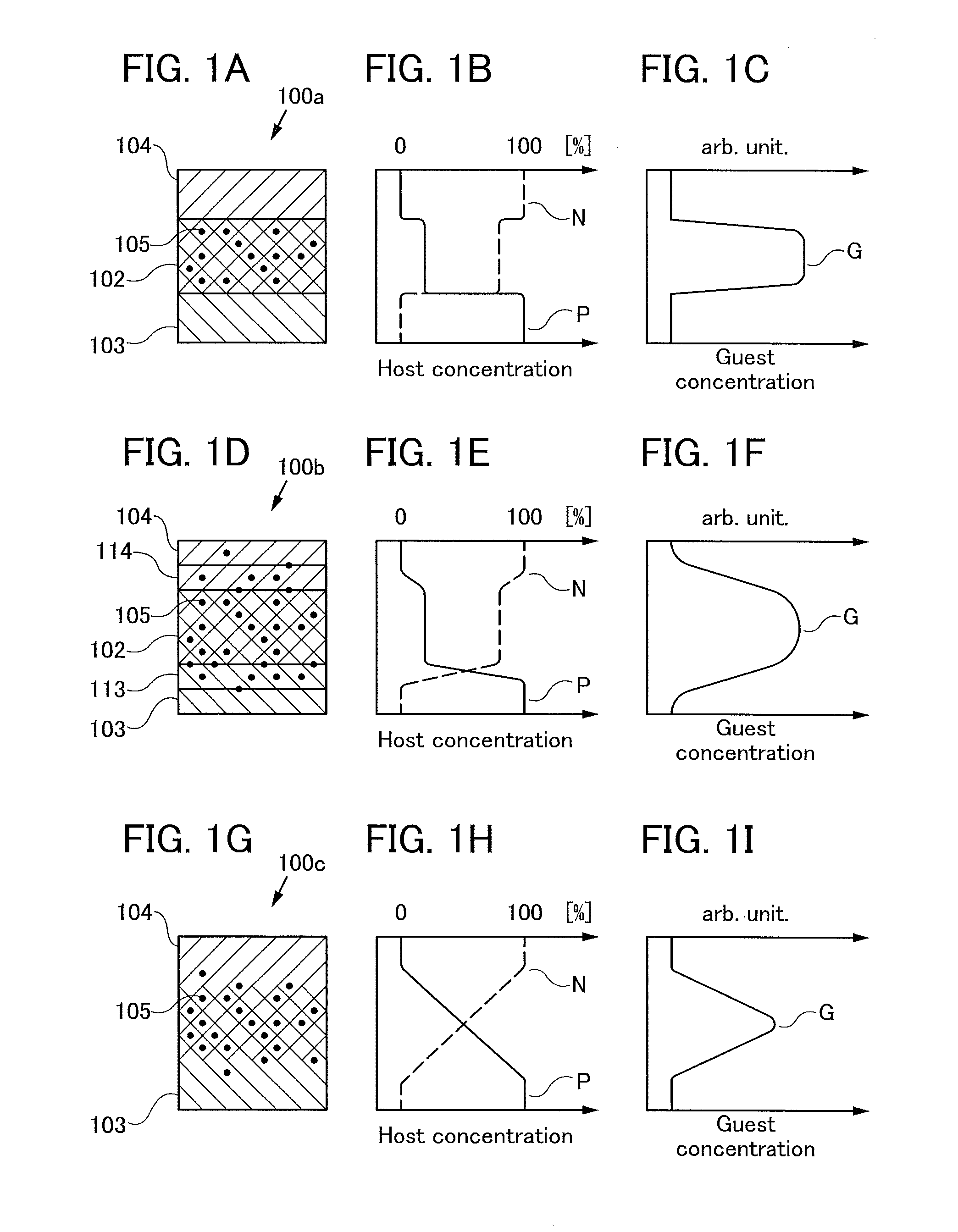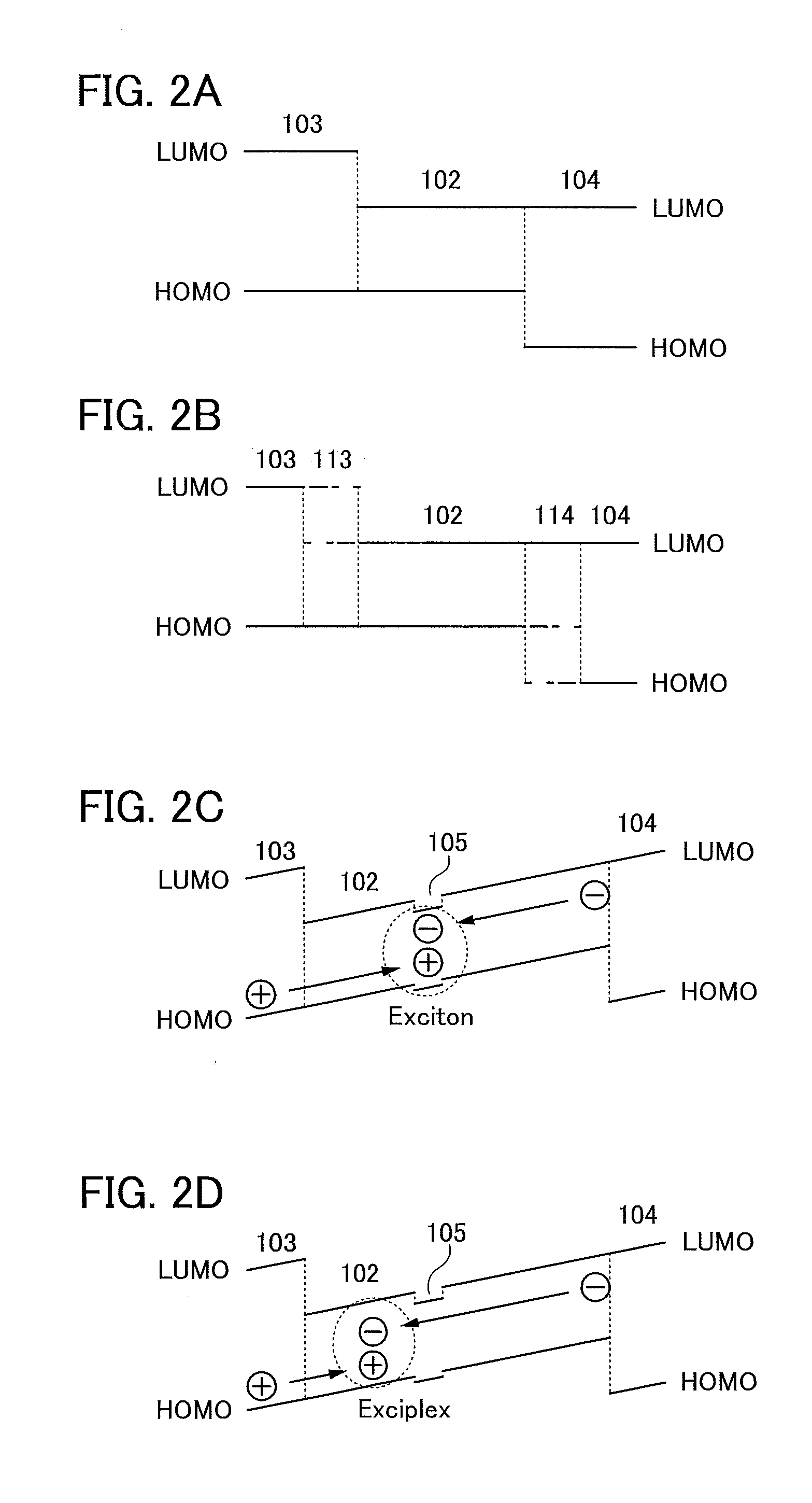Light-Emitting Element
a technology of light-emitting elements and energy transfer, which is applied in the field of light-emitting elements, can solve the problems of increasing drive voltage, reducing power efficiency, and insufficient utilization of energy transfer from the singlet excited state of the host to the guest, and achieves the effects of low power consumption, high emission efficiency, and reduced barrier to carrier injection
- Summary
- Abstract
- Description
- Claims
- Application Information
AI Technical Summary
Benefits of technology
Problems solved by technology
Method used
Image
Examples
embodiment 1
[0078]In this embodiment, a light-emitting element of one embodiment of the present invention will be described with reference to FIGS. 1A to 1I and FIGS. 2A to 2D.
[0079]A light-emitting element of one embodiment of the present invention includes a layer (an EL layer) containing a light-emitting organic compound between a pair of electrodes (a first electrode and a second electrode). One of the pair of electrodes functions as an anode and the other functions as a cathode. The EL layer includes a first layer over the first electrode, a light-emitting layer over the first layer, and a second layer over the light-emitting layer. The light-emitting layer contains a phosphorescent compound (a guest), a first organic compound, and a second organic compound, where the content of the second organic compound is the highest. The first layer contains the first organic compound and does not contain the second organic compound. The second layer contains the second organic compound and does not c...
embodiment 2
[0140]In this embodiment, a light-emitting element of one embodiment of the present invention will be described with reference to FIGS. 3A to 3D.
[0141]The light-emitting element of this embodiment includes an EL layer between a pair of electrodes (an anode and a cathode).
[0142]A light-emitting element illustrated in FIG. 3A includes only a stack 100 as an EL layer between an anode 101 and a cathode 109. Any of the stacks 100a to 100c described in Embodiment 1 may be applied to the stack 100 in this embodiment. Note that in each of the stacks, the layer 103 containing the p-type host is provided on the anode 101 side and the layer 104 containing the n-type host is provided on the cathode 109 side. At least one of the anode 101 and the cathode 109 has a property of transmitting visible light.
[0143]In the stack 100 of the light-emitting element illustrated in FIG. 3A, the layer 103 containing the p-type host functions as a hole-transport layer and blocks electrons. Further, the layer 1...
embodiment 3
[0182]In this embodiment, apparatuses for manufacturing a light-emitting element of one embodiment of the present invention will be described with reference to FIGS. 4A to 4C.
[0183]A manufacturing apparatus illustrated in FIG. 4A includes a first deposition material holding portion 202, a second deposition material holding portion 203, and a third deposition material holding portion 204 in a vacuum chamber 201. The deposition material holding portions described in this embodiment each have a linear opening portion (see a linear opening portion 223 of the first deposition material holding portion 202 which is illustrated in FIG. 4C) and can be used to evaporate a deposition material therein by a resistance heating method.
[0184]In this embodiment, the first deposition material holding portion 202, the second deposition material holding portion 203, and the third deposition material holding portion 204 cause the p-type host, the guest, and the n-type host to evaporate, respectively. Th...
PUM
 Login to View More
Login to View More Abstract
Description
Claims
Application Information
 Login to View More
Login to View More - R&D
- Intellectual Property
- Life Sciences
- Materials
- Tech Scout
- Unparalleled Data Quality
- Higher Quality Content
- 60% Fewer Hallucinations
Browse by: Latest US Patents, China's latest patents, Technical Efficacy Thesaurus, Application Domain, Technology Topic, Popular Technical Reports.
© 2025 PatSnap. All rights reserved.Legal|Privacy policy|Modern Slavery Act Transparency Statement|Sitemap|About US| Contact US: help@patsnap.com



